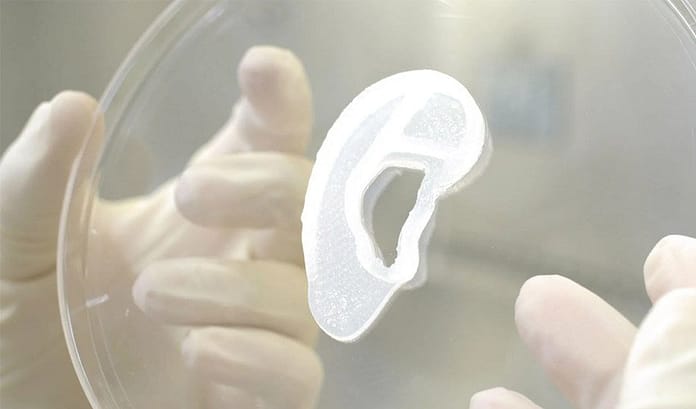In the United States, a surgeon successfully implanted an ear implant designed from human cells! It is 3DBio Therapeutics that is the origin of this implant for a 20-year-old woman. She had a pinna in her right ear, a congenital anomaly that prevents the outer ear from growing. The implant is called AuriNovo, and it would have been 3D-printed from a patient’s own cartilage cells and collagen hydrogel. This is the first time this device has been tested clinically — trials should be conducted on a total of 11 patients in California and Texas.
One of the biggest challenges in the bioprinting sector is this phase of clinical trials: it is necessary to ensure the safety, efficacy and durability of 3D-printed implants and organs. Because if you’ve followed the news, you’ve definitely heard of bioprinted hearts, 3D printed kidneys, etc. There is still a long way to go before these solutions are implanted into the patient, but this ear implant is more than an encouraging start!

On the left is the patient before the operation. Right, patient 30 days after operation (Image credits: Dr. Arturo Bonilla, Microtia Institute of Congenital Ear)
Current treatments to correct the pinna consist of designing a prosthesis of cartilage taken from the patient’s ribs – a very laborious process. This prosthesis can also be made of porous polyethylene, which is a less flexible material. This is where 3D printing comes in on its own. Dr. Arturo Bonilla is the surgeon who performed the procedure on the young woman: “As a physician who has treated thousands of children with small ears across the country and around the world, I am inspired by what this technology can mean for Mikrotia patients and their families. This study will allow us to investigate the safety and properties The aesthetics of reconstructing the new ear using the patient’s own cartilage cells”.
3D printed ear making process
The first step in implant fabrication is a sample of cartilage from the patient’s right ear – both teams determine that half a gram is sufficient. A 3D scan of the left ear is performed in parallel. Next, 3DBio Therapeutics technology isolates the cells responsible for cartilage formation from the sample and cultures them in a patented nutrient mixture, allowing these cells to proliferate. It is then mixed with the bio-ink developed by the company; The whole is inserted into the bioprinter’s syringe. In just 10 minutes, a replica of a patient’s ear can be made, layer by layer.

Bioprinting process on the ear (Image credits: 3DBio Therapeutics)
Once the printing process is complete, the ear is placed in a biodegradable protective sleeve and sent to Dr. Then the surgeon took care of the patch under the patient’s skin. The shape of the ear appears very clearly once the skin around the implant is stretched.
Professor Anthony Atala, Director of the Wake Forest Institute for Regenerative Medicine, creator of the first 3D bioprinted kidney project, spoke about this 3D bioprinted ear: This is an important step forward in the field of regenerative medicine. 3D printing aims to offer a number of advantages over man-made synthetic fabrics, including scalability, greater design accuracy, and lower costs.. It remains to be seen if other planned clinical trials will be conclusive – we hope so anyway!
What do you think of 3D printed ear implants? Share your opinion with us in the comments of the article. Find all our videos on our channel Youtube or follow us Facebook or Twitter !


